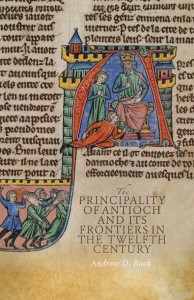Andrew D. Buck
The Principality of Antioch and its Frontiers in the Twelfth Century
(Boydell, 2017) 296 pp. $99.00
The Principality of Antioch was one of the more obscure Crusader states and it has received comparatively less attention than, for example, the Kingdom of Jerusalem. Additionally, throughout its history the principality had wide changes in orders over the course of the twelfth century, dealing with drastic changes in territory that would have challenged the survival of many other realms. The author, understandably, seeks to find within the history of Frankish Antioch insights regarding what allowed the state to be so resilient in the face of massive external pressures against resurgent Muslim states like Aleppo, rival crusader states like Edessa, Tripoli, and the Kingdom of Jerusalem, as well as the Armenians and Byzantine Empire. Recognizing the flexibility of government in the face of serious pressures is something that is of use in better understanding the capabilities of medieval rulership, allowing us to better respect the rulers of the Middle Ages as competent rulers. Given our contemporary concern about borders, this book provides a useful examination of the concerns of a frontier state in a state of frequent crisis.
In light of the purpose of the author in discussing the management of the realm of the Principality of Antioch by its twelfth century leaders, it is worthwhile to examine the contents of this book in some detail. The roughly two-hundred and fifty pages of written material (aside from the extensive bibliography and index) is contained in seven chapters and two appendices. Unusually, the two appendices are not placed after the conclusion but rather after the chapters they seek to explain in greater detail. Perhaps the author chose this unconventional form of organization in order to encourage more people to read the appendices than otherwise would in a more usual structure. After a helpful introduction the author discusses the history of the borders of the Principality, the rulers of Antioch, and central governance and military service. After this third chapter comes the book’s first appendix on a listing of the known officers of the principality from the limited prosographical evidence from 1127-1201. Then comes a discussion of lordship in the principality and the second appendix on the noble families. The last three chapters look at the nature of intercultural relations between the different ethnic groups within the principality and the ambiguity of the language for various ethnic groups, the relationship between the principality and Byzantium, and the relationship between Antioch and the rest of the Latin east.
This text presents some serious demands to the reader. Reading this book will be far easier and far more enjoyable if the reader has some sort of context in understanding the complicated political and military histories of the various crusader states. Additionally, the author presents a revisionist case that argues against too great a predominant role for the Kingdom of Jerusalem, presenting a case that other crusader states could and, at times, did challenge Jerusalem for leadership and that, at best, the Kingdom of Jerusalem was a first among equals. Moreover, the author argues convincingly that the principality of Antioch had considerable leeway in terms of its own diplomacy, and that the combination of strength, weakness, and strategic importance provided encouragement for alliances at critical times during the tumultuous twelfth century. Overall, the author is particularly interested in questions about the relationships of power inside the principality and between the principality and its neighbors: “Importantly, renewed examination of the relationships of power reveals that traditional historical conceptions of the Frankish presence in northern Syria offer a misleading picture of what it meant to live and rule on the eastern frontier of Latin Christendom. Such conclusions contribute not only towards modern understanding of the nature and diversity of the Latin East, but also of the wider divergence and individualities of the medieval world (16-17).” In the closing part of the introduction, the author gives a strong reason as to why a study of the Principality of Antioch repays the effort for medieval military historians: “Whether through a distinct sensitivity to the region’s topographical pressure points, the astute managing of diplomatic and military alliances, or the forging of internal frameworks of power, the frequency with which the Antiochenes demonstrated their adaptability to emerging situations is testament to the need for historians to recognize the principality’s place within the wider context of medieval frontiers. A place of fluid and dynamic customs, Antioch’s rich history is worthy of greater interest and knowledge – a gap this book seeks to fill (19).”
This particular book is mainly of interest to scholars of the Latin East with a graduate or possibly upperclassman level of education. Clearly the author expects the reader to have some understanding of the crusades to begin with, as they form an essential part of the context of the work itself although by no means the main focus, which is on the ordinary leadership within the principality based on what can be understood through internal and comparative textual analysis. It is remarkable that the author is able to come to such a nuanced and complex understanding of Antioch’s government and military and diplomatic behavior from such limited textual evidence as exists for the period in question. Indeed, with greater textual evidence it would be possible to know more about some of the noble families of the principality, their demenses, and what place they served within the central government of the principality. As it is, though, much of this evidence is simply not available at present. For those readers who have an understanding of the crusader states and are interested in knowing more about the political and diplomatic and military history of the Principality of Antioch, this book represents an able and detailed and thorough account of the twelfth century. It will hopefully find an appreciative academic market given the popularity of studies about the Crusades within the academic community of medieval military historians.
Nathan Albright
Norwich University

